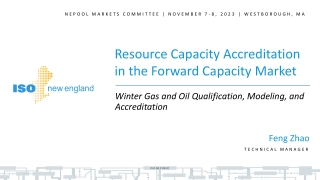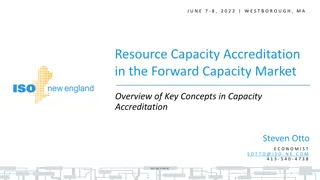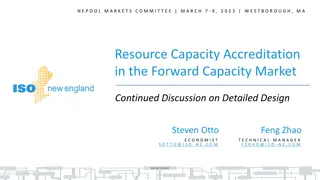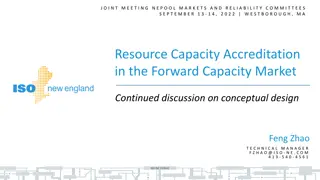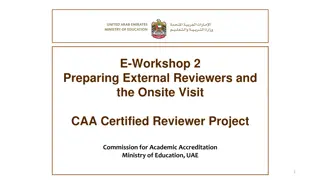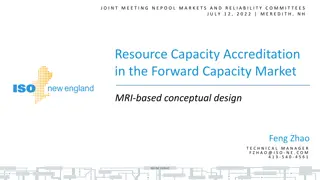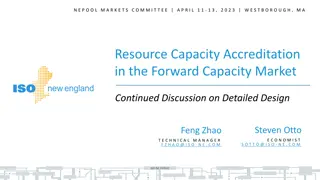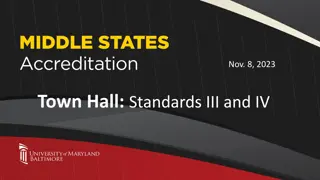Forward Capacity Market Resource Capacity Accreditation Discussion
Discussion on improvements to resource capacity accreditation in the Forward Capacity Market to support a reliable, clean-energy transition by accrediting resource contributions effectively as the resource mix evolves. Covers conceptual design, stakeholder schedule, and review of proposed enhancements for FCA 19.
Download Presentation

Please find below an Image/Link to download the presentation.
The content on the website is provided AS IS for your information and personal use only. It may not be sold, licensed, or shared on other websites without obtaining consent from the author.If you encounter any issues during the download, it is possible that the publisher has removed the file from their server.
You are allowed to download the files provided on this website for personal or commercial use, subject to the condition that they are used lawfully. All files are the property of their respective owners.
The content on the website is provided AS IS for your information and personal use only. It may not be sold, licensed, or shared on other websites without obtaining consent from the author.
E N D
Presentation Transcript
J O I N T M E E T I N G N E P O O L M A R K E T S A N D R E L I A B I L I T Y C O M M I T T E E S A U G U S T 9 , 2 0 2 2 | W E S T B O R O U G H , M A Resource Capacity Accreditation in the Forward Capacity Market Continued discussion on conceptual design Feng Zhao T E C H N I C A L M A N A G E R F Z H A O @ I S O - N E . C O M 4 1 3 - 5 4 0 - 4 5 6 1 ISO-NE PUBLIC
WMPP ID: 157 Resource Capacity Accreditation in the Forward Capacity Market Proposed Effective Date: FCA 19 The Resource Capacity Accreditation (RCA) project proposes improvements to ISO-NE s accreditation processes in the Forward Capacity Market (FCM) to further support a reliable, clean-energy transition by implementing methodologies that will more appropriately accredit resource contributions to resource adequacy as the resource mix transforms The ISO has made a commitment to FERC to file proposed improvements in time for FCA 19 In July, the ISO presented its conceptual design at a high level This presentation illustrates the key conceptual design components with a numerical example Graphs and numerical examples do not reflect estimates of the impacts of potential reforms but are merely stylized examples ISO-NE PUBLIC 2
WMPP ID: 157 Resource Capacity Accreditation in the Forward Capacity Market Proposed Effective Date: FCA 19 Outline of today s discussion: Review of the RCA improvements (slides 5-6) Review of the MRI-based conceptual design (slides 8-11) Illustrative example for the conceptual design (slides 13-49) Response to conceptual design questions (slides 51-52) Conclusion (slide 54) Stakeholder schedule (slides 56-59) ISO-NE PUBLIC 3
REVIEW OF RCA IMPROVEMENTS ISO-NE PUBLIC ISO-NE PUBLIC 4
Capacity Accreditation In general, resource capacity accreditation quantifies resources reliability contributions The accredited value is the maximum amount of capacity that a resource can sell in FCM ISO-NE currently uses a resource s Qualified Capacity (QC) value as its capacity accreditation value The reliability contributions of 1 MW QC from different resources may not be substitutable ISO-NE PUBLIC 5
Opportunities for Improvement Opportunity #1: Current capacity accreditation framework can be improved to reflect different resource contributions toward resource adequacy. These adjustments will better yield accredited capacity that is substitutable between resources, which is beneficial as unique resource types enter the market RCA will implement a MRI framework that improves resource substitutability Opportunity #2: Current resource adequacy assessment process can be improved to better reflect resources expected performance and reliability contributions as the resource mix changes RCA will improve resource adequacy assessment modelsfor more accurate calculation of resource accreditation values ISO-NE PUBLIC 6
REVIEW OF MRI-BASED CONCEPTUAL DESIGN ISO-NE PUBLIC ISO-NE PUBLIC 7
MRI-based Capacity Accreditation Framework As explained in July, there are several key components of the MRI-based capacity accreditation proposal, which are summarized below: Each resource s Marginal Reliability Impact (MRI), in hours/year, represents the Expected Unserved Energy (EUE) change over a small increase of QC: MRI= EUE/ QC Each resource s relativeMarginal Reliability Impact (rMRI) to perfect capacity is a ratio (no units): rMRI = MRI/MRIperfect Each resource s new accredited capacity, Qualified MRI Capacity (QMRIC), will be calculated in MW: QMRIC = QC rMRI rMRI Qualified Capacity (QC) Qualified MRIC (QMRIC) ISO-NE PUBLIC 8
MRI-based Capacity Accreditation Under MRI-based accreditation, two obligations are produced subsequent to market clearing The new Capacity Supply Obligation (CSO) or cleared QMRIC, a market quantity used for capacity base payment, etc. The Effective CSO (ECSO) associated with CSO, a physical representation of CSO used for FCM reliability reviews, etc. FCM Clearing Physical & market quantity Current: CSO QC Physical quantity QC ECSO New: 1/rMRI rMRI FCM Clearing Market quantity CSO QMRIC ISO-NE PUBLIC 9
Capacity Demand Curves The ISO has already applied the MRI concept to its capacity demand curves Zonal Demand Curves By applying the same MRI concept and consistent resource mix assumptions to both supply and demand sides of FCM, the supply and demand will properly align MRI-based Demand Curve MRI-based Resource QC accreditation Accreditation ISO-NE PUBLIC 10
Resource Adequacy Assessment Model Enhancements Resource Adequacy Assessment (RAA) models will be enhanced to allow more accurate calculation of resources MRI The current load shape in RAA will be enhanced with a composite load shape reflecting representative summer and winter weather conditions Intermittent resource models such as solar and wind will be enhanced with hourly output profiles Energy storage resource models will be enhanced Gas-only resource models will be improved by incorporating gas supply constraints Starting in September, more details about the proposed model enhancements will be discussed ISO-NE PUBLIC 11
CONCEPTUAL DESIGN EXAMPLE Parameters and models ISO-NE PUBLIC ISO-NE PUBLIC 12
Example Roadmap In July, the ISO presented the high-level conceptual design In the following slides, a small numerical example is used to illustrate the key elements of the MRI-based design: Simplified RAA process Calculation of MRI, rMRI and QMRIC using RAA Calculation of the new capacity requirement FCM clearing Resource capacity obligations (CSO and ECSO) The simplified models and processes illustrated in this stylized example do not reflect estimates of the impacts of potential reforms ISO-NE PUBLIC 13
Example Assumptions Consider a FCA with two existing resources (A and B), and one new resource (C) The assumed resource parameters are summarized in the table below Nameplate (MW) Resource Type QC (MW) A Existing 100 100 B Existing 100 20 C New 50 10 ISO-NE PUBLIC 14
Example Assumptions, cont. Resource model: Resource A is modeled with two states: 100 MW and 0 MW with probabilities of 0.9 and 0.1, respectively Resource B is modeled by an output profile: (0%, 20%, 100%) of its nameplate capacity, each with equal probability of 1/3 Resource C has the same output profile as B, and its MW output is always half of B s at any time The outputs of resources A and B are independent Load model: Consider a single peak load level of 99 MW, which is expected to occur in 0.25 days/year and in 4 hours of the peak day (or 1 hour/year = 0.25 x 4) For simplicity of analysis, other off-peak load levels are assumed to have no reliability risk and are thus not considered ISO-NE PUBLIC 15
CONCEPTUAL DESIGN EXAMPLE Simplified RAA Process ISO-NE PUBLIC ISO-NE PUBLIC 16
Example Simplified RAA Roadmap RAA is used to calculate ICR (demand-side) currently and will be used to calculate resource MRIs (supply-side) under the RCA design In this section, We start with a high-level review of the general RAA simulation process A simplified RAA is then introduced for the simplicity of analysis The simplified RAA is used to demonstrate the evaluation of reliability indices for the example ISO-NE PUBLIC 17
Example General RAA Process RAA performs probabilistic analysis on a system of load and resource models to evaluate system adequacy/reliability indices such as LOLE and EUE (illustrated in the below figure) Resource parameters (QC, EFORd, etc.) Load parameters RAA models (load and resources) Monte-Carlo simulation Reliability metrics (EUE, LOLE, etc.) RAA tool (GE-MARS) Details of RAA process will be reviewed in the coming meetings ISO-NE PUBLIC 18
Example Simplified RAA for Illustration In this example, only one peak load level and two existing resources (i.e., A and B) are modeled for ICR calculation New resource C is not modeled (following current RAA practice) The number of resource output combinations or scenarios for the two existing resources is a small number Monte-Carlo simulation is replaced by simply enumerating all scenarios LOLE/EUE is calculated by analyzing results from the scenarios The above simplified RAA process can be illustrated for the example with a scenario table as shown next ISO-NE PUBLIC 19
Example Scenario Table for Simplified RAA Resource scenarios of the example are summarized in the below table: Scenario 1 2 3 4 5 6 A (MW) 0 0 0 100 100 100 B (MW) 0 20 100 0 20 100 Total MW 0 20 100 100 120 200 Scenario Prob. 0.1 1/3 0.1 1/3 0.1 1/3 0.9 1/3 0.9 1/3 0.9 1/3 LOL (MW) 99 79 0 0 0 0 LOLE and EUE can be calculated from the outcome of scenarios 1 and 2 with LOL Load = 99 MW, expected days/year or 1 hour/year E.g., LOL will occur under the peak load ( days/year) and scenarios 1 and 2 (total probability 0.2/3) LOLE = x 0.2/3 = 0.05/3 days/year < 0.1 days/year ISO-NE PUBLIC 20
CONCEPTUAL DESIGN EXAMPLE ICR calculation and ICR base case ISO-NE PUBLIC ISO-NE PUBLIC 21
Example ICR Roadmap In the previous section, we illustrated a simplified RAA process In this section, the simplified RAA is used to calculate the ICR (which will be used later for calculating the MRIC requirement) and define the base case for MRI calculation ISO-NE PUBLIC 22
ICR Key Concepts ICR is the minimum amount of installed capacity to meet ISO-NE s resource planning criterion (i.e., LOLE 1 day in 10 years) RAA is used to evaluate LOLE for given system of existing resources and load Load modeled in RAA may need to be adjusted by the amount of Additional Load Carrying Capability (ALCC) to bring system LOLE to 1-in-10 Currently, ICR is calculated as For additional background, please refer to the ICR Reference Guide and the ICR Development Webinar ICR =???????? ???????? ??? ???????? ??4 ?????? 1 + ???? ???? ?????? ???? ISO-NE PUBLIC 23
Example Simplified ICR Calculation Next we demonstrate how to calculate ICR (which will be translated to MRIC requirement later) for the example using the scenario table The previous analysis shows that for the example, the existing resource mix (A and B) and the peak load yield LOLE < 0.1 days/year The load modeled RAA needs to be adjusted by ALCC in MW to achieve the LOLE criterion of 0.1 days/year The next slide shows that increasing the load by 9 MW will achieve the LOLE criterion for this example, i.e., ALCC = 9 MW, and the simplified ICR (ignoring tie benefits, OP4 relief, and HQICCs) for the example is ???????? ????????/ (1 + ???? ????) = 110 MW ???? ISO-NE PUBLIC 24
Example Simplified ICR Calculation, cont. It is shown below that with an increased peak load of 108 MW (expected days/year), scenarios 1-4 (total probability of 0.4) yield LOL LOLE = 0.4 = 0.1 days/year ALCC = 108-99 = 9 MW, Existing Capacity measured in QC = 100 + 20 = 120 MW ??? = 120 / (1+9/99) = 110 MW Scenario 1 2 3 4 5 6 Adjusted Load = 108 MW, expected days/year or 1 hour/year A (MW) 0 0 0 100 100 100 B (MW) 0 20 100 0 20 100 Total MW 0 20 100 100 120 200 Scenario Prob. 0.1 1/3 0.1 1/3 0.1 1/3 0.9 1/3 0.9 1/3 0.9 1/3 LOL (MW) 108 88 8 8 0 0 LOL scenarios under the ALCC- adjusted load ISO-NE PUBLIC 25
Example ICR Base Case The at-criterion ICR base case is composed of existing resources and the ALCC-adjusted load The base case is used for calculating capacity demand curves (demand-side) and resource MRIs (supply-side) In this example, the base case is composed of the adjusted peak load of 108 MW (expected days/year or 1 hour/year) and the resource mix of A and B The ICR base case will be used to calculate the resource MRIs in the next section ISO-NE PUBLIC 26
Key Takeaways on ICR and Base Case Installed Capacity Requirement (ICR), calculated by using the RAA process, is measured by QC amount ICR can be translated to MRIC amount as illustrated in a later section (slides 38-40) The base case and its assumptions used in RAA for the ICR calculation will be used for the MRI calculation ISO-NE PUBLIC 27
CONCEPTUAL DESIGN EXAMPLE Calculating resource MRI, rMRI and QMRIC ISO-NE PUBLIC ISO-NE PUBLIC 28
Example MRI Roadmap In the previous section, we established ICR and the base case for the example In this section, the base case is used to calculate resource MRIs (new process under RCA): To calculate MRI of a resource, its QC is increased by a small amount of 1 MW, and the scenario table is used to analyze the EUE change To calculate the relative MRI of each resource to perfect capacity, the MRI of perfect capacity is calculated by adding 1 MW of its capacity With these MRIs, the rMRI and QMRIC of each resource are calculated ISO-NE PUBLIC 29
Example MRI Calculation Under the MRI-based capacity accreditation, resource MRIs are calculated based on EUE impacts of small changes to the resource QC: MRI = EUE / QC hours/year MWh/year MW Next we use the scenario table to analyze the MRI for the two existing resources modeled in the base case For each resource, its QC is increased by a small amount of 1 MW and the resulting EUE change is analyzed ISO-NE PUBLIC 30
Example MRI for Resource A The below table shows that increasing resource A s QC by 1 MW leads to 1 MW reduction of LOL under scenario 4 (with probability 0.3) and the adjusted load (expected 1 hour/year) EUE = 1 MW 0.3 1 hours/year = 0.3 MWh/year MRIA = 0.3 hours/year Scenario 1 2 3 4 5 6 Adjusted Load = 108 MW, expected days/year or 1 hour/year A (MW) 0 0 0 100 1 100 1 100 1 B (MW) 0 20 100 0 20 100 Total MW 0 20 100 100 1 120 1 200 1 Scenario Prob. 0.1 1/3 0.1 1/3 0.1 1/3 0.9 1/3 0.9 1/3 0.9 1/3 LOL (MW) 108 88 8 8 1 0 0 ISO-NE PUBLIC 31
Example MRI for Resource B Increasing resource B s 20 MW QC by 1 MW is equivalent to proportionally increasing its output profile to (0 MW, 21 MW, 105 MW), which leads to 1 MW LOL reduction of scenario 2 and 5 MW reduction of scenario 3 The EUE is reduced by (1 MW 0.1/3 + 5 MW 0.1/3) x 1 hour/year = 0.2 MWh/year MRIB = 0.2 hours/year Scenario A (MW) B (MW) Total MW 1 0 0 0 2 0 20 1 20 1 3 0 100 5 100 5 4 100 0 100 5 100 20 1 120 1 6 100 100 5 200 5 Adjusted Load = 108 MW, expected days/year or 1 hour/year Scenario Prob. 0.1 1/3 0.1 1/3 0.1 1/3 0.9 1/3 0.9 1/3 0.9 1/3 LOL (MW) 108 88 1 8 5 8 0 0 ISO-NE PUBLIC 32
Example MRI for Resource C New resource C is not modeled in the base case and therefore its MRI cannot be calculated by using the RAA We propose to use the MRI of an existing resource or class (with similar technology, location, etc.) for new resources In the small example, new resource C is assumed to have the same location and technology as B MRI of resource B is used for resource C, i.e., MRIC = MRIB = 0.2 hours/year ISO-NE PUBLIC 33
Example MRI for Perfect Capacity Adding 1 MW of perfect capacity will result in a 1 MW reduction of LOL for each LOL scenario (i.e., scenarios 1-4 with total probability of 0.4 = 0.1/3+ 0.1/3+ 0.1/3+0.3) EUE is reduced by 1 MW 0.4 1 hour/year = 0.4 MWh/year MRIperfect = 0.4 hours/year Scenario 1 2 3 4 5 6 Adjusted Load = 108 MW, expected days/year or 1 hour/year A (MW) 0 0 0 100 100 100 B (MW) 0 20 100 0 20 100 Total MW 0 20 100 100 120 200 Scenario Prob. 0.1 1/3 0.1 1/3 0.1 1/3 0.9 1/3 0.9 1/3 0.9 1/3 LOL (MW) 108 1 88 1 8 1 8 1 0 0 Perfect Capacity 1 ISO-NE PUBLIC 34
Example Resource rMRI By comparing a resource s marginal reliability impact to that of the perfect capacity s, the resource s relative Marginal Reliability Impact (rMRI) is represented by ???? = ???/?????????? rMRI allows each resource s capacity to be expressed in the same unit of perfect capacity With the previously calculated MRIA = 0.3, MRIB = MRIC = 0.2 and MRIperfect = 0.4, we have rMRIA = 0.3/0.4 = 0.75, rMRIB = rMRIC = 0.2/0.4 = 0.5 ISO-NE PUBLIC 35
Example Resource QMRICs With resource rMRIs calculated, the QC of each resource can be translated to the equivalent QMRIC amount of perfect capacity: ????? = ?? ???? QMRIC for resources of the example are summarized below: Resource QC (MW) MRI (hours/year) rMRI QMRIC (MW) A 100 0.3 0.75 75 B 20 0.2 0.5 10 C 10 0.2 0.5 5 Perfect Capacity - 0.4 1 - ISO-NE PUBLIC 36
CONCEPTUAL DESIGN EXAMPLE MRIC requirement ISO-NE PUBLIC ISO-NE PUBLIC 37
Example MRIC Requirement Roadmap In the previous sections, we have calculated the ICR (110 MW) and resource MRIs for the small example This section translates the ICR measured in QC to the new MRIC requirement by using resource MRIs ISO-NE PUBLIC 38
Example Requirement for MRIC Under the MRI-based design, the QC-based ICR (110 MW for the example) is translated to the MRIC requirement Base case is composed of resource A (100 MW QC) and resource B (20 MW QC) Each MW QC of base case resource mix has 5/6 MW QCA and 1/6 MW QCB MRIC of 1 MW resource mix = 5 MRIC requirement = ICR 17/24 = 110 17/24 = 77.92 MW 6 rMRIA + 1 6 rMRIB = 5 6 0.75+ 1 6 0.5 = 17/24 Existing capacity MRIC Req. ICR Perfect capacity Base case mix ISO-NE PUBLIC 39
Example Supply and Demand in MRIC With MRI-based capacity accreditation and capacity requirement, both supply and demand quantities are in MRIC (allowing substitutability between resources and demand) ISO-NE PUBLIC 40
CONCEPTUAL DESIGN EXAMPLE FCM clearing ISO-NE PUBLIC ISO-NE PUBLIC 41
Example FCM Clearing Roadmap In the previous section, we calculated resource QMRIC and system MRIC demand for the example This section will demonstrate the FCM clearing for the MRIC product ISO-NE PUBLIC 42
Example Capacity Offers QMRIC-based offer prices based on offer costs for the three resources are listed in the below table Price formation will be discussed in coming months All offers are assumed rationable (no lumpiness) QC (MW) rMRI QMRIC (MW) Cost QMRIC Offer Price ($/kw m) ( $106/year) A 100 0.75 75 4.8 5.33 B 20 0.5 10 0.48 4 C 10 0.5 5 0.36 6 Demand 110 17/24 77.92 ISO-NE PUBLIC 43
Example Capacity Market Clearing FCM clears at the intersection of the aggregated offer curve and the MRIC requirement (illustrated in the below figure) Capacity clearing price is set by resource A at $5.33/kw-m Capacity demand curves instead of fixed requirement will be used in practice MRIC Req. = 77.92 MW $/kw-m Aggregated offers 6 5.33 4 C A B 10 85 90 MRIC (MW) ISO-NE PUBLIC 44
CONCEPTUAL DESIGN EXAMPLE Resource Obligations ISO-NE PUBLIC ISO-NE PUBLIC 45
Example Resource Obligations Roadmap Under the MRI-based design, resource obligation is separated into CSO (market) and ECSO (physical) This section demonstrates the CSO and ECSO for the resources in the example as a result of FCM clearing The numbers in this stylized example do not reflect estimates of the market impacts of potential reforms ISO-NE PUBLIC 46
Example Capacity Obligations Resource B obtains CSO of 10 MW; resource A has CSO of 67.92 MW (=77.92 10); resource C has zero CSO The market quantity of CSO can be translated back to the physical quantity of ECSO for each resource: ECSO = CSO x 1/rMRI The CSO and ECO of the three resources are listed in the below table: QC (MW) rMRI QMRIC (MW) CSO (MW) ECSO (MW) A 100 0.75 75 67.92 90.56 B 20 0.5 10 10 20 C 10 0.5 5 0 0 Demand 110 17/24 77.92 The use of capacity obligations will be discussed in the coming meetings ISO-NE PUBLIC 47
CONCEPTUAL DESIGN EXAMPLE Key Takeaways ISO-NE PUBLIC ISO-NE PUBLIC 48
Example Key Takeaways RCA allows an MRI-based framework for both capacity demand curve construction and resource accreditation We will cover more details on specific components of the MRI- based design starting September ISO-NE PUBLIC 49
ADDITIONAL CONCEPTUAL DESIGN QUESTIONS ISO-NE PUBLIC ISO-NE PUBLIC 50


